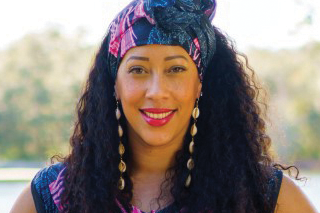Current Features
Addressing Disparities
Physical, behavioral health issues experienced by people of color ‘aren’t just about health’

By TOM WOOLF | USF News
WHEN KYAIEN CONNER TALKS about health disparities experienced by people of color, she draws not only from extensive training and her background as a mental health practitioner, educator and researcher, but also from painful personal experience.

Prior to joining USF’s faculty in 2013, Conner lived in Pittsburgh. She vividly recalls driving home from an event with her family and being stopped four separate times by police – who offered no reasons for pulling them over.
“We were questioned as to why we were in that area, if the car was ours,” she says. “During the fourth stop, my husband was asked to get out of the car so the police could do a search. My two young sons were in the back seat.”
The incident illustrates the importance of recognizing that physical and mental health disparities experienced by people of color “aren’t just about health.”
“They are about disparities in all aspects of society that lead people to feel that they are being marginalized, mistreated and discriminated against,” she says. “Those are among the factors that enhance stress and fear, which are directly connected to health. You can’t separate those and say this is only about treatment or access to a doctor. Those are important. But all of those other societal elements have a daily impact on people of color. Every time you walk out of the house, you know that being Black will impact all of the interactions that you have. That stress impacts your body, it impacts how you move through the world, it has a direct impact on health.”
An associate professor of mental health law and policy, Conner is helping prepare USF students for careers as behavioral health or health care providers. A course that she developed, Cultural Diversity, Health and Behavioral Health, is designed specifically to help undergraduates “understand the historical implications of health disparities that are significant realities in communities they go into.”
One of those realities is the widespread reluctance in communities of color to seek professional mental health services.
“My passion for being a mental health service provider and working specifically with the Black community stemmed from my early recognition that seeking those services just wasn’t discussed or was seen as a last resort, if it was even considered an option,” Conner says, adding that she has encountered such reluctance in various communities of color.
“There is a cultural idea that talking to outsiders about things of a sensitive nature, such as mental health, is just taboo,” she says. “It’s something you keep in your family or that you pray about, but you don’t seek outside professional help. People don’t want to associate with terms like depression. In my research, people would often say ‘I just have the blues’ or ‘I’m not depressed,’ but when you ask questions on a scale that identifies depression, they would score off the charts.”
That reluctance stems, at least in part, from the historical issue of mistrust of the health-care system that extends to mental health care providers. Conner calls that mistrust “pervasive,” noting that African Americans are half as likely to seek mental health services as whites.
“It stems from real histories of abuse and mistreatment between the Black community and the medical/health field, as well as academics who have used communities of color to build research careers, publish papers and then leave them with nothing to show for it,” she says. “Community-based participatory research is vital – research projects that go into communities and partner with them to determine what their needs are, develop strategies for addressing those collaboratively, and engage community at each level of the research process.”
In her own research, Conner focuses on mental health disparities facing ethnic minorities in engagement, retention and psychosocial outcomes. She recently received a three-year, $1.7 million grant from the Patient-Centered Outcomes Research Institute for community-engaged work with local Area Agencies on Aging. She will assist in identifying some of the issues related to behavioral health in older African American and Hispanic populations, specifically the factors that lead to hospital re-admissions.
She also has received a $100,000 Florida Department of Health grant for a pilot study of a cultural drumming intervention to improve psychosocial outcomes among African Americans with early stage Alzheimer’s disease and their caregivers. Conner, who has been a professional West African dancer since she was 14, is the artistic director for Tampa’s Kuumba Dancers and Drummers.
“I can integrate my passion for the arts with cultural intervention strategies that we know from our observations are effective,” she says.
Though disrupted by the coronavirus pandemic, the program involves drummers performing in adult day-care centers around Tampa.
“They lead beautiful drum circles where older adults with Alzheimer’s, many of whom can’t talk, are able to hit a drum, make a rhythm, and you see them light up,” Conner says. “We’ve been able to see preliminarily some improvements in agitation reduction and to their moods. These programs connect people with each other and have an impact on their well-being.”
Also essential are more providers of color in health care and behavioral health – providers who are culturally competent, Conner emphasizes. Much of her research suggests that “the inclusion of culturally meaningful values, language and strategies that are targeted for the Black community lead to enhanced rapport, a greater feeling of collaboration and inclusion on the part of the client, and ultimately better clinical outcomes.”
Even if mental health resources are available in Black communities – which Conner says is not the norm – people are not aware of them.
“As such, Black people are significantly less likely to utilize professional mental health services and their first experience with mental health treatment is in the criminal justice system or in the emergency room when they are in crisis,” she says.
Eliminating disparities requires complex solutions to a variety of social determinants of health, including education, housing and income.
“It’s so much bigger than health,” Conner says. “It’s hard because in the U.S., talking about race is uncomfortable. But you can’t change what you don’t acknowledge.
“The average wealth of a white family in the U.S. is seven times more than a Black family, and that gap is larger in 2020 than when we started keeping track of this in 1983,” she says. “This is critically correlated because wealth is a predictor of positive health outcomes. We need research to better understand some of these specific disparities and develop strategies to address them.”